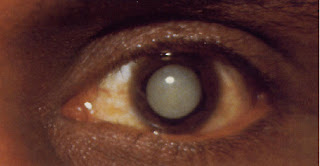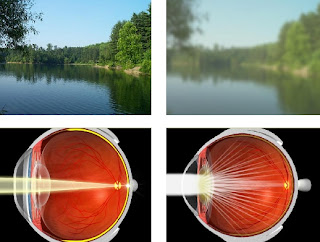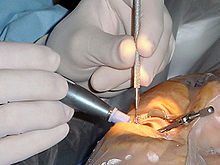A cataract is a clouding that develops in the crystalline lens of the eye or in its envelope, varying in degree from slight to complete opacity and obstructing the passage of light. Early in the development of age-related cataract the power of the lens may be increased, causing near-sightedness (myopia), and the gradual yellowing and opacification of the lens may reduce the perception of blue colours. Cataracts typically progress slowly to cause vision loss and are potentially blinding if untreated. The condition usually affects both the eyes, but almost always one eye is affected earlier than the other.
A senile cataract, occurring in the elderly, is characterized by an initial opacity in the lens, subsequent swelling of the lens and final shrinkage with complete loss of transparency. Moreover, with time the cataract cortex liquefies to form a milky white fluid in a Morgagnian cataract, which can cause severe inflammation if the lens capsule ruptures and leaks. Untreated, the cataract can cause phacomorphic glaucoma. Very advanced cataracts with weak zonules are liable to dislocation anteriorly or posteriorly. Such spontaneous posterior dislocations (akin to the historical surgical procedure of couching) in ancient times were regarded as a blessing from the heavens, because some perception of light was restored in the cataractous patients.
Cataract derives from the Latin cataracta meaning "waterfall" and the Greek kataraktes and katarrhaktes, from katarassein meaning "to dash down" (kata-, "down"; arassein, "to strike, dash"). As rapidly running water turns white, the term may later have been used metaphorically to describe the similar appearance of mature ocular opacities. In Latin, cataracta had the alternate meaning "portcullis",so it is also possible that the name came about through the sense of "obstruction". Early Persian physicians called the term nazul-i-ah, or "descent of the water"—vulgarised into waterfall disease or cataract—believing such blindness to be caused by an outpouring of corrupt humour into the eye. In dialect English a cataract is called a pearl, as in "pearl eye" and "pearl-eyed".
Classification
The following is a classification of the various types of cataracts. This is not comprehensive and other unusual types may be noted.
- Classified by etiology
- Age-related cataract
- Cortical Senile Cataract
- Immature senile cataract (IMSC): partially opaque lens, disc view hazy
- Mature senile cataract (MSC): Completely opaque lens, no disc view
- Hypermature senile cataract (HMSC): Liquefied cortical matter: Morgagnian cataract
- Senile Nuclear Cataract
- Cataracta brunescens
- cataracta nigra
- cataracta rubra
- Congenital cataract
- Sutural cataract
- Lamellar cataract
- Zonular cataract
- Total cataract

Slit lamp photo of anterior capsular opacification visible a few months after implantation of Intraocular lens in eye, magnified view
-
- Drug-induced cataract (e.g. corticosteroids)
- Traumatic cataract
- Blunt trauma (capsule usually intact)
- Penetrating trauma (capsular rupture & leakage of lens material—calls for an emergency surgery for extraction of lens and leaked material to minimize further damage)
- Classified by opacities, cataract can be classified by using Lens Opacities Classification System III (LOCS III: Nuclear NC1-5, Cortical C1-5 and Posterior P1-5. By application planning in procedures of phacoemulsification, LCOS III can be converted in newer cataract grading system. Gede Pardianto (2009) introduced Optical Biometry Based Cataract Grading System (OBBCGS) that so helpful in cataract grading due to phacoemulsification planning. LOCS III's NC0, C0 and P0 acan be converted as OBBCGS' No cataract (NC), LOCS III's NC1-3, C1-3, P1-4 can be converted to OBBCGS' Optical Biometry Examined Cataract (OBEC) and LOCS III's NC4-5, C4-5, P4-5 can be converted to OBBCGS's Optical Biometry Un-examined Cataract (OBUC); that need examination by Applanation Ultrasound Biometry.
- Classified by location of opacity within lens structure (However, mixed morphology is quite commonly seen, e.g. PSC with nuclear changes & cortical spokes of cataract)
- Anterior cortical cataract
- Anterior polar cataract
- Anterior subcapsular cataract

Slit lamp photo of posterior capsular opacification visible a few months after implantation of Intraocular lens in eye, seen on retroillumination
- Nuclear cataract—Grading correlates with hardness & difficulty of surgical removal
- Posterior cortical cataract
- Posterior polar cataract (importance lies in higher risk of complication—posterior capsular tears during surgery)
- Posterior subcapsular cataract (PSC) (clinically common)
- After-cataract: posterior capsular opacification (PCO) subsequent to a successful extracapsular cataract surgery (usually within three months to two years) with or without IOL implantation. Requires a quick & painless office procedure with Nd:YAG laser capsulotomy to restore optical clarity.
Signs and symptoms
As a cataract becomes more opaque, clear vision is compromised. A loss of visual acuity is noted. Contrast sensitivity is also lost, so that contours, shadows and color vision are less vivid. Veiling glare can be a problem as light is scattered by the cataract into the eye. The affected eye will have an absent red reflex. A contrast sensitivity test should be performed and if a loss in contrast sensitivity is demonstrated an eye specialist consultation is recommended.
In the developed world, particularly in high-risk groups such as diabetics, it may be advisable to seek medical opinion if a 'halo' is observed around street lights at night, especially if this phenomenon appears to be confined to one eye only.
The symptoms of cataracts are very similar to the symptoms of ocular citrosis.
Causes
Cataracts develop for a variety of reasons, including long-term exposure to ultraviolet light, exposure to radiation, secondary effects of diseases such as diabetes, hypertension and advanced age, or trauma (possibly much earlier); they are usually a result of denaturation of lens protein. Genetic factors are often a cause of congenital cataracts and positive family history may also play a role in predisposing someone to cataracts at an earlier age, a phenomenon of "anticipation" in pre-senile cataracts. Cataracts may also be produced by eye injury or physical trauma. A study among Icelandair pilots showed commercial airline pilots are three times more likely to develop cataracts than people with non-flying jobs. This is thought to be caused by excessive exposure to radiation coming from outer space. Cataracts are also unusually common in persons exposed to infrared radiation, such as glassblowers who suffer from "exfoliation syndrome". Exposure to microwave radiation can cause cataracts. Atopic or allergic conditions are also known to quicken the progression of cataracts, especially in children. Cataracts can also be caused by iodine deficien
Cataracts may be partial or complete, stationary or progressive, hard or soft.
Some drugs can induce cataract development, such as corticosteroids and Seroquel.
There are various types of cataracts, e.g. nuclear, cortical, mature, and hypermature. Cataracts are also classified by their location, e.g. posterior (classically due to steroid use) and anterior (common (senile) cataract related to aging).
Associations with systemic conditions
- Disease of the skin and mucous membranes
- Congenital
- Others
- Toxic substances introduced systemically
Prevention
Although cataracts have no scientifically proven prevention, it is sometimes said that wearing ultraviolet-protecting sunglasses may slow the development of cataracts.Regular intake of antioxidants (such as vitamin A, C and E) is theoretically helpful, but taking them as a supplement has been shown to have no benefit. The less well known antioxidant N-acetylcarnosine has been shown in randomized controlled clinical trials to treat cataracts, and can be expected to prevent their formation by similar mechanisms. N-acetylcarnosine is a proposed treatment for other ocular disorders that are instigated, or exacerbated by oxidative stress including glaucoma, retinal degeneration, corneal disordes, and ocular inflammation.
Treatment
Main article: Cataract surgery
When a cataract is sufficiently developed to be removed by surgery, the most effective and common treatment is to make an incision (capsulotomy) into the capsule of the cloudy lens in order to surgically remove the lens. There are two types of eye surgery that can be used to remove cataracts: extra-capsular (extracapsular cataract extraction, or ECCE) and intra-capsular (intracapsular cataract extraction, or ICCE).
Extra-capsular (ECCE) surgery consists of removing the lens but leaving the majority of the lens capsuleHigh frequency sound waves (phacoemulsification) are sometimes used to break up the lens before extraction. intact.
Intra-capsular (ICCE) surgery involves removing the entire lens of the eye, including the lens capsule, but it is rarely performed in modern practice.
In either extra-capsular surgery or intra-capsular surgery, the cataractous lens is removed and replaced with a plastic lens (an intraocular lens implant) which stays in the eye permanently.
Cataract operations are usually performed using a local anaesthetic and the patient is allowed to go home the same day. Recent improvements in intraocular technology now allow cataract patients to choose a multifocal lens to create a visual environment in which they are less dependent on glasses. Under some medical systems multifocal lenses cost extra. Traditional intraocular lenses are monofocal.
Complications are possible after cataract surgery, including endophthalmitis, posterior capsular opacificationretinal detachment.





No comments:
Post a Comment